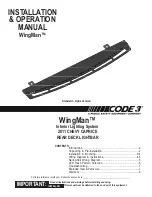
AWD
GCWR (Gross Combined Weight Rating)/Trailer Weight
Engine
Rear axle ratio Maximum
GCWR-lb. (kg)
Trailer weight
range-lb. (kg)
(0-Maximum)
4.0L SOHC Class
II towing
3.73
8500 (3856)
0–3500 (0–1588)
4.6L* Class II
towing
3.55
8500 (3856)
0–3500 (0–1588)
4.0L SOHC Class
III/IV towing
3.73
10000 (4536)
0–5000 (0–2268)
4.6L* Class III/IV
towing
3.55
12000 (5443)
0–7000 (0–3175)
Notes:
- For high altitude operation, reduce GCW by 2% per 1,000 ft.
(300 meters) elevation. For definitions of terms used in this table and
instructions on how to calculate your vehicle load, refer to
Vehicle
loading
in this chapter. Maximum trailer weights shown. The combined
weight of the completed towing vehicle and the loaded trailer must not
exceed the GCWR
* -When towing maximum loads under high outside temperatures
and/or on steep grades, the A/C system may cycle on and off to protect
the engine from overheating. This may result in a temporary increase
of interior temperatures.
Preparing to tow
Use the proper equipment for towing a trailer and make sure it is
properly attached to your vehicle. See your authorized dealer or a
reliable trailer dealer if you require assistance.
Hitches
Do not use hitches that clamp onto the vehicle bumper. Use a load
carrying hitch. You must distribute the load in your trailer so that
10–15% of the total weight of the trailer is on the tongue, not to exceed
the maximum tongue loads as stated:
•
Class II receiver: 350 lb. (159 kg)
•
Class III/IV receiver: 500 lb. (227 kg) (weight carrying); 740 lb. (336
kg) (weight distributing)
2008 07+ Explorer Sport Trac
(esp)
Owners Guide (post-2002-fmt)
USA
(fus)
Tires, Wheels and Loading
248
















































